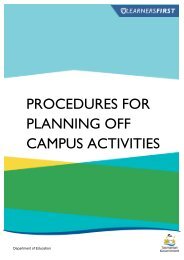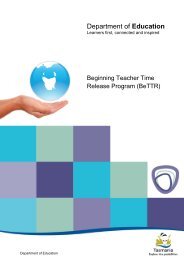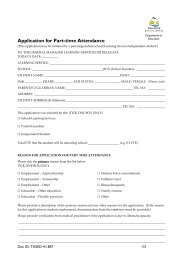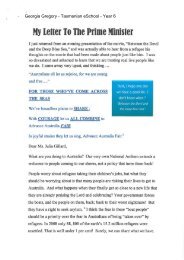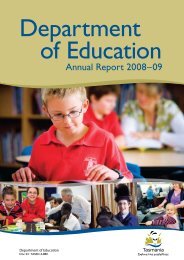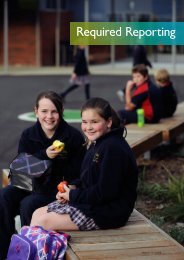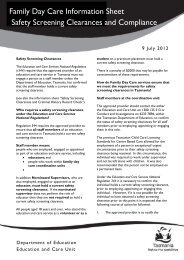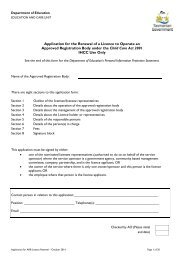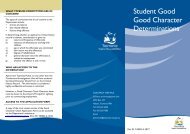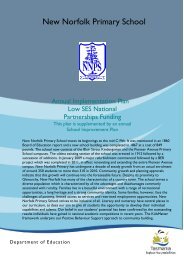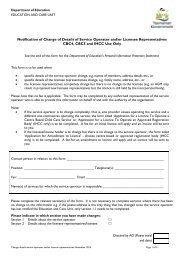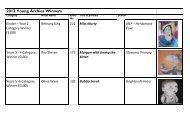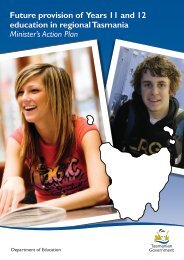Department of Education
DoE Annual Report 2010-2011 - Department of Education
DoE Annual Report 2010-2011 - Department of Education
- No tags were found...
You also want an ePaper? Increase the reach of your titles
YUMPU automatically turns print PDFs into web optimized ePapers that Google loves.
Strategic Focus<br />
In 2010–11, the <strong>Department</strong> <strong>of</strong> <strong>Education</strong> has responsibility<br />
for learners throughout all stages <strong>of</strong> life, from birth to<br />
early adulthood and into adult life. This presents exciting<br />
opportunities to further integrate and collaborate across the<br />
department, and to provide comprehensive lifelong learning<br />
for all Tasmanians.<br />
Together, the department’s three output groups:<br />
Pre-Compulsory and Compulsory <strong>Education</strong> (birth to 18<br />
years), Post-Compulsory <strong>Education</strong> and Skills Development,<br />
and LINC Tasmania, underpin the department’s strategic<br />
priorities. The achievement <strong>of</strong> outcomes is supported<br />
by business units providing corporate support, policy<br />
development, regulation and reporting on educational<br />
performance.<br />
The department’s strategic priorities include the early years,<br />
literacy and numeracy, and retention into post-Year 10<br />
education and training. The work undertaken in the early<br />
years, schools, colleges <strong>of</strong> the Tasmanian Academy and the<br />
Tasmanian Polytechnic, and LINC Tasmania is critical in<br />
helping us to achieve our two overarching goals <strong>of</strong> enabling<br />
every Tasmanian to reach their potential at all stages <strong>of</strong><br />
life and nurturing a culturally rich, socially cohesive and<br />
economically productive community.<br />
Early years initiatives<br />
The Launching into Learning (LiL) initiative continues to provide<br />
significant advancement within the department’s early years<br />
priority. In 2010, research revealed the significant and positive<br />
influence that LiL is having on student performance from<br />
all socioeconomic backgrounds, and particularly for the<br />
most disadvantaged students. The department is increasing<br />
its investment in LiL and the early years with an additional<br />
$2 million – bringing total funding to $6.4 million.<br />
LiL will continue to target support to areas <strong>of</strong> greatest need<br />
in supporting parents as their child’s first and <strong>of</strong>ten most<br />
influential teachers, and to provide a cooperative interface<br />
between families, early years services and agencies in local<br />
communities.<br />
The early years priority is further supported through the<br />
establishment <strong>of</strong> integrated child and family centres across<br />
the state. The centres provide a local setting for families,<br />
service providers, the local community, and government and<br />
non-government organisations to work together to provide<br />
quality, accessible and integrated programs and services.<br />
In 2011–12, $25.4 million in capital funding will enable the<br />
construction <strong>of</strong> 11 centres across the state, with one major<br />
centre already open and six centres to be opened by the<br />
end <strong>of</strong> 2011. This is a project <strong>of</strong> strategic importance for the<br />
department and the Tasmanian Government.<br />
Two centres in development are funded under the National<br />
Partnership for Indigenous Early Childhood Development. The<br />
process for their establishment is mirroring the process being<br />
followed by state funded centres, and will feature strong<br />
Aboriginal community engagement and the employment <strong>of</strong><br />
Aboriginal staff.<br />
The Australian Government also has the early years at the<br />
top <strong>of</strong> its educational agenda and, as such, the Council <strong>of</strong><br />
Australian Governments (COAG) endorsed the Australian<br />
Early Development Index (AEDI) as a national progress<br />
measure <strong>of</strong> young children’s early health and development in<br />
the years before they start school. The Tasmanian results <strong>of</strong><br />
the AEDI confirm the value <strong>of</strong> the government’s focus on the<br />
early years and the decision to locate child and family centres<br />
in the most vulnerable communities.<br />
The introduction <strong>of</strong> the national Early Years Learning<br />
Framework provides a curriculum framework for Kindergarten<br />
and child care services and programs throughout the state.<br />
The framework is an essential part <strong>of</strong> the transition to the<br />
National Quality Framework, which will be fully implemented<br />
in 2012. There has been a significant level <strong>of</strong> action by the<br />
department towards this transition through 2010–11.<br />
Literacy and numeracy focus<br />
The department is continuing its strong focus on literacy<br />
and numeracy improvement through three Smarter School<br />
National Partnerships: Literacy and Numeracy, Improving Teacher<br />
Quality and Low Socio-economic Status School Communities. The<br />
partnerships, which are co-investments with the Australian<br />
Government, provide significant support for improving<br />
literacy and numeracy in schools.<br />
Schools are being further supported to improve literacy and<br />
numeracy outcomes with the extension <strong>of</strong> the innovative<br />
and successful Raising the Bar Closing the Gap (RTBCTG)<br />
program into secondary schools. The RTBCTG 7 Up program<br />
complements the existing program in primary schools,<br />
which assists identified schools to develop a whole-<strong>of</strong>-school<br />
approach to literacy and numeracy improvement.<br />
Considerable focus has been given to the Adult Literacy<br />
Action Plan, which aims to improve the core skills levels <strong>of</strong><br />
Tasmanians—to improve access to, and participation in,<br />
further education, employment and training. This plan is being<br />
jointly implemented by Skills Tasmania and LINC Tasmania<br />
with the establishment <strong>of</strong> a community and workplace<br />
network <strong>of</strong> adult literacy support, a statewide team <strong>of</strong><br />
coordinators and trained volunteers, the Employer Pledge<br />
Program and the Adult Literacy Community Grants Program. This<br />
plan forms part <strong>of</strong> an $11 million investment over four years.<br />
Improving Aboriginal education<br />
outcomes<br />
The department has recently released the state’s Aboriginal<br />
education strategy Closing the Gap on Aboriginal <strong>Education</strong><br />
Outcomes 2010–2014: a strategy for Aboriginal student<br />
success through school improvement. This strategy outlines<br />
initiatives to improve the success <strong>of</strong> Aboriginal students<br />
in schools by supporting the particular needs <strong>of</strong> individual<br />
schools, students and their families. Support is provided<br />
for selected focus schools to ensure that intensive effort<br />
is dedicated to those Aboriginal students with the highest<br />
needs.<br />
The strategy also includes initiatives for building the capacity<br />
<strong>of</strong> the Tasmanian education system to deliver the quality,<br />
inclusive teaching and leadership necessary to achieve the<br />
targets set for improvement in Aboriginal student outcomes.<br />
The department has been allocated a further $1.9 million<br />
over two years by the Australian Government for an<br />
extension literacy and numeracy program for Aboriginal<br />
students. The implementation <strong>of</strong> this will be consistent with<br />
the Raising the Bar Closing the Gap initiative, and funding is<br />
being directed to five high Aboriginal enrolment and high<br />
need schools.<br />
Curriculum development<br />
In 2011, the Tasmanian Curriculum continues as the required<br />
curriculum for all government primary and secondary<br />
schools. The first stage <strong>of</strong> the new Australian Curriculum will<br />
be released in 2012, aligning teaching and learning with all<br />
other Australian states and territories. This will mean some<br />
4<br />
<strong>Department</strong> at a Glance – Strategic Focus



